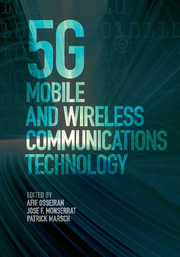Book contents
- Frontmatter
- Dedication
- Contents
- List of contributors
- Foreword
- Acknowledgments
- Acronyms
- 1 Introduction
- 2 5G use cases and system concept
- 3 The 5G architecture
- 4 Machine-type communications
- 5 Device-to-device (D2D) communications
- 6 Millimeter wave communications
- 7 The 5G radio-access technologies
- 8 Massive multiple-input multiple-output (MIMO) systems
- 9 Coordinated multi-point transmission in 5G
- 10 Relaying and wireless network coding
- 11 Interference management, mobility management, and dynamic reconfiguration
- 12 Spectrum
- 13 The 5G wireless propagation channel models
- 14 Simulation methodology
- Index
- References
12 - Spectrum
Published online by Cambridge University Press: 05 June 2016
- Frontmatter
- Dedication
- Contents
- List of contributors
- Foreword
- Acknowledgments
- Acronyms
- 1 Introduction
- 2 5G use cases and system concept
- 3 The 5G architecture
- 4 Machine-type communications
- 5 Device-to-device (D2D) communications
- 6 Millimeter wave communications
- 7 The 5G radio-access technologies
- 8 Massive multiple-input multiple-output (MIMO) systems
- 9 Coordinated multi-point transmission in 5G
- 10 Relaying and wireless network coding
- 11 Interference management, mobility management, and dynamic reconfiguration
- 12 Spectrum
- 13 The 5G wireless propagation channel models
- 14 Simulation methodology
- Index
- References
Summary
This chapter examines and investigates the available choices for spectrum in the 5G system. The relative attractiveness of specific choices of spectrum for various 5G scenarios is identified. The chapter is presented in two parts.
The first part provides an overview of the spectrum landscape leading up to the deployment of 5G. Several new frequency bands with differing regulatory restrictions are expected to be suitable as candidates. It is likely that some bands will require shared use of spectrum. Consequently, this chapter identifies and describes the relevant future modes of spectrum access. Further, this chapter investigates the resulting technical requirements pertaining to shared spectrum use for the 5G system.
The second part of this chapter describes the most important and promising technology components for spectrum access in more detail. A key concept discussed is a flexible spectrum management architecture accompanied by a spectrum-sharing toolbox composed of components that will aid and arbitrate access to spectrum assets, subject to various sharing criteria. Finally, techno-economic analysis of spectrum and related enablers are presented.
Introduction
Spectrum is a key resource for any radio access network. The availability of spectrum has consistently driven the mobile communication industry through four generations of cellular radio systems, providing telecommunications services with ever-increasing capacity. Early generations of systems were built to provide mobile telephone services, then expanded to handle information services, rich communication services, and media delivery.
The drivers for high network capacity are (1) availability of spectrum while accounting for abundance, cost of acquisition and operation (2) demand in terms of the traffic that is driven through the network, (3) diversity of services that can maintain load in a network across all hours of a day, (4) the multiplexing capability of the Internet Protocol (IP), and (5) the computational ability provided by the advances in semiconductor technology increasing processing power and lowering storage cost. The last four of these factors constitute a seemingly endless growth potential to the market, while the first, availability of spectrum, is currently under stress.
The availability of spectrum in suitable frequency ranges, and the efficiency with which it is used, do affect the achievable network capacity and performance. While appropriate market-based pricing of spectrum has consistently motivated the tremendous improvements in network capacity through increased spectral efficiency, scarcity of spectrum could lead to stagnation of the mobile telecommunication industry.
- Type
- Chapter
- Information
- 5G Mobile and Wireless Communications Technology , pp. 336 - 356Publisher: Cambridge University PressPrint publication year: 2016
References
- 1
- Cited by

